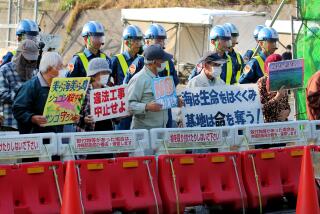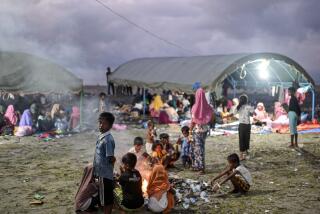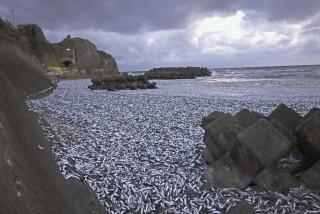North Korean ships with corpses on board have been washing ashore in Japan
- Share via
reporting from WAJIMA, Japan — Shizuo Kakutani sees no great mystery in the things that wash ashore in Monzen, his quiet fishing village on the Sea of Japan — the fishing boats ravaged by fierce winter storms, the Chinese garbage carried to land by the strong winds, the occasional body that drifts in from Yaseno, the nearby cliffs notorious for suicides.
The ghost ships, however, are harder to explain.
On an early morning in November, the 71-year-old retired fisherman received a call from his colleagues at the town’s civilian coast guard. A black mass bobbling in the water — most likely a boat — had been spotted hooked to a distant buoy.
Join the conversation on Facebook >>
“When I saw the boat, I immediately knew that it was from North Korea,” Kakutani said. He had seen similar vessels before — no more than 30 feet long, made of wood, its flat-bottomed hull covered in black tar.
“Then, as we were pulling the boat to this port, we noticed a pair of legs sticking out from underneath, bobbing up and down with the waves,” Kakutani said. Later that day, they discovered two more boats and a grisly cargo of 10 bodies, all badly decomposed.
In small towns along Japan’s sleepy west coast, dozens of North Korean boats drift ashore each year — and while most arrive empty or reduced to kindling, some float eerily out of the haze with a crew of bodies, adding to the mystery of a country that cloaks itself in secrecy.
A flotilla of the ghost boats — at least 14 of them, carrying more than 30 decomposing corpses — has washed ashore since late last year along a 1,000-mile stretch of the west coast, leaving Japanese investigators puzzled. Who were these people? What happened to them?
The boats bore unmistakable signs of North Korean origin. Their hulls were emblazoned with painted numbers and Korean script; one was marked “State Security Department,” and another “Korean People’s Army.” A tattered North Korean flag flew from one of the boats, the newspaper Asahi Shimbun reported. A backpack, found on another, had a pin bearing the portrait of North Korean leader Kim Jong Il, who died in 2011.
All of those on board appeared to be male, though some were so badly decomposed investigators couldn’t be certain. All wore civilian clothing. Autopsies found that they had been dead for about two months, but the cause of death was elusive.
Perhaps they were defectors, analysts surmised — although scores of have attempted to flee the country in recent years, few have dared to cross the freezing, storm-tossed sea. Most travel overland into northeastern China.
Then, a new theory surfaced.
Satoru Miyamoto, a North Korea expert at Japan’s Seigakuin University near Tokyo, said that the men on board were probably fishermen. By studying photographs of the boats and the vessels’ numbers, he deduced they probably belonged to the North Korean military’s commercial branch.
The basis for those conclusions might be found in a series of undated photographs released in November of dictator Kim Jong Un touring a military fishery base, grinning and examining blocks of frozen fish.
Workers, Kim said, should “realize their lifetime desire by catching more fish for the servicepersons and civilians,” according to the official Korean Central News Agency.
“So the military has been sending soldiers out onto the sea to fish,” Miyamoto said. “But the soldiers don’t have any training, so they sometimes get lost at sea.”
The crews may have run into extreme weather, a typhoon perhaps. Boats may have flipped and righted themselves again. Those aboard probably drowned, starved or succumbed to hypothermia.
A search of the boat Kakutani helped bring to shore in November revealed what must have been a wretched existence for those on board.
There were so few things in there, said Kiyohito Tani, 52, a coast guard group leader who conducted the search.
There was a frying pan and a cabin strewn with fishing hooks and small lights, suggesting the crew intended to catch squid, he said. There were three bodies below deck, all decomposed.
“It smelled like them,” he said. “It’s something very difficult to describe.”
Six more bodies were found in one of the other two boats that were found that day, one of the vessels with only its hull protruding from the water.
This isn’t something new for us, so people are just saying ‘oh no, not again.’
— Shizuo Kakutani, 71
Kakutani was more mystified than alarmed by the ghost ships; the fishing town has long been awash in macabre discoveries.
“This isn’t something new for us, so people are just saying ‘oh no, not again,’” Kakutani said.
Kakutani said that responding to suicides on nearby Yaseno — five or six each year — has hardened him.
“We have a rumor of a ghostly figure of a lady appearing at the pier,” he said. “But that’s been a rumor since way before the North Korean ships began arriving. So probably, she’s just one of those people who jumped to death from the cliff.”
And the arrivals have continued. In January, fishermen in Niigata found a small boat — apparently from North Korea — partially submerged about eight miles from the city’s coastline. It remains in the city’s port awaiting demolition, with all of its contents: fishing nets, a man’s jacket, a rusty old motor.
Kazushi Nishikata, 37, a spokesman at the Niigata coast guard, said investigators found a pack of cigarettes bearing Korean script on board.
“I remember it was whitish-colored,” he said in an interview at his office. He then left the room to find a picture of the cigarette pack, but returned empty-handed. “A body was just found in a river near here,” he said, shrugging. “Everybody’s busy checking it out. So I can’t look into this right now.”
Coast guard officials said that disposing of the boats has been a bureaucratic hassle. The three boats discovered off Monzen floated unattended for months before they were dismantled, destroyed and incinerated in February. Wajima, the municipality that oversees the town of Monzen, couldn’t afford their disposal, leaving the local environmental ministry to cover most of the $13,500 bill.
A Wajima government spokesperson, reached by phone, said those aboard, presumed to be North Koreans, were cremated and their ashes sent to the Soujiji temple, a placid Zen Buddhist compound on the city’s outskirts. A monk at the temple confirmed that the ashes were there, but declined to say more — commenting on the situation, he said, could invite reprisals.
Between 1977 and 1983, North Korean agents abducted at least 17 Japanese citizens — including several who lived nearby. Some locals, he said, still seek retribution.
“They’re being held no differently than the other ashes,” the monk said. “In death, we treat everyone the same.”
ALSO
A student’s death inflames tension between Egypt and Italy
North Korea claims successful test of rocket engine capable of reaching U.S.
New defense in Russian’s hacking case requests another delay to go through piles of evidence
More to Read
Sign up for Essential California
The most important California stories and recommendations in your inbox every morning.
You may occasionally receive promotional content from the Los Angeles Times.










